|
   |
|
Page 6 |
Newsletter 105, Summer 2014 © Hampshire Mills Group |
Hampshire Mills Group Trip to Devon
9th to 11th May 2014
David Plunkett
|
|
The
long awaited (three day) mills and
industrial
archaeology
trip to
greater Devon arranged through our chairman Andy
Fish, started early morning from John Silman’s home
in Chandlers Ford.
Andy
was also our driver and creator of the illustrated
twenty two page programme. There may have been only
nine of us senior citizens on board but we have
known each other for many years and with Mick
Edgeworth as navigator, time passed very quickly on
the first leg to Lyme Regis.
|

Town Mill, Lyme Regis |
This
was Town Mill, hidden away on very narrow streets up
from the Cobb. The modern history of this mill is
one of successful and sustained development with
added brewery, bakery and art studio using adjacent
old buildings.
This is
an operational watermill, open to the public,
producing wholemeal by
an
overshot fed waterwheel and electrical power from
the modern water turbine. Outside, the sheltered
courtyard with tables and chairs to relax in and a
drink of your choice.
|
|
So,
westwards on to Otterton Mill. Still part of the
Clinton Devon Estate which has been restored to
working order from 1977. Now owned by the Spiller
family from 2008 and stated to be the most
productive watermill in Devon, and surprisingly,
open to visitors free of charge throughout the year.
Travelling further north next into Somerset, we came
to Coldharbour Textile Mill of a size and mass to
equal many in the Midlands.
Built
by Thomas Fox in 1799, it became renowned for its
high quality worsted yarn and cloth which was
exported globally. Though closed to production in
1981, it reopened as Coldharbour Mill Trust as a
textile museum in 1982.
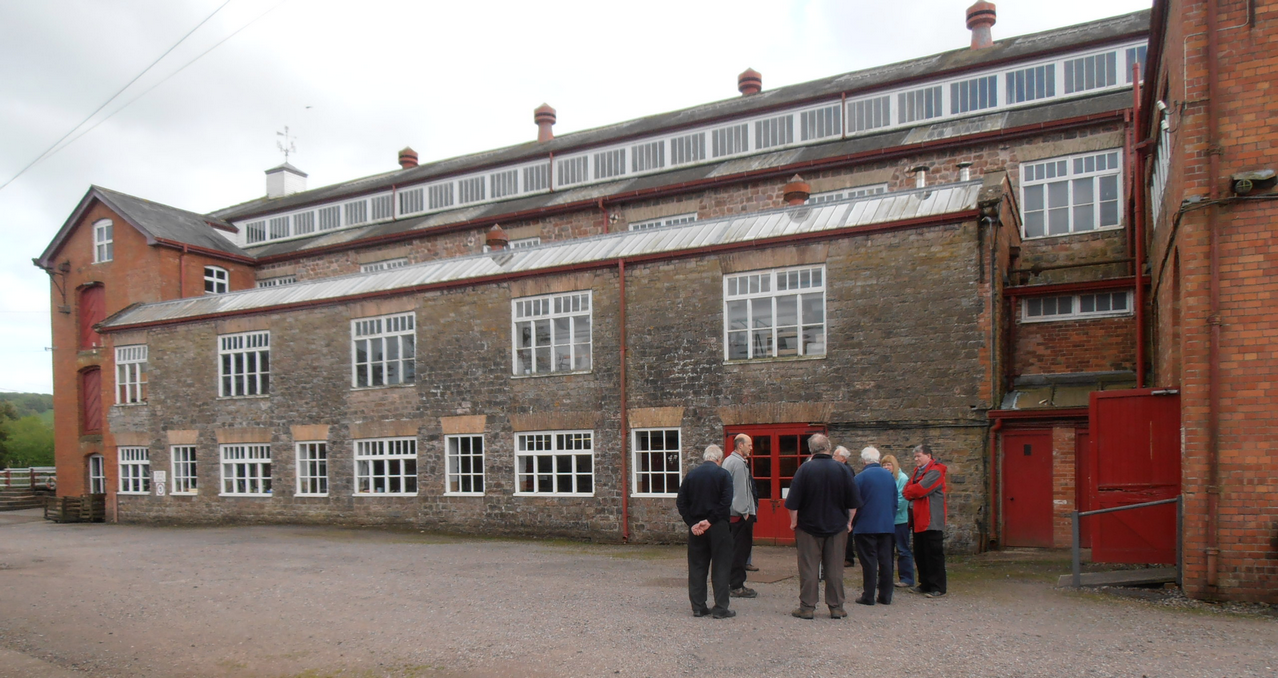
Coldharbour Textile Mill
It has
the largest waterwheel in the south west, dating
from 1821, an 1867 beam engine and a rare 1910,
300hp steam engine with Lancashire boiler. A
fascinating range of machinery in working order and
museum display items including production equipment
to make ‘puttey’s for our army in former times. It
was not far to find our accommodation for the next
two nights as the modernised Tiverton Travelodge,
not far off the M5.
Our
evening dining and socialising was about half a mile
down the road at the Waterloo Inn, which suited us
all well. After a good nights rest, most of us
opted for a drive out for an old fashion breakfast
about two miles away Excellent in all respects, so
we promised to return for more on the Sunday
morning.
We were soon loaded up and heading towards the
north coast at Dunster Mill, within the Dunster
Castle grounds.
This Mill is owned by the National Trust and was
officially closed at this time for urgent
conservation works but HMG have a knack of getting
into mills where others are turned away. The NT
Administrator was especially interested in our group
and the expertise which we could provide for this
mill.
Our
programme provided nearly four pages of information
on this mill and local history which is very
informative. One of the two overshot waterwheels is
in use and trial milling has commenced.
A very
interesting collection of farm and mill related
machinery and equipment is displayed as is also a
Howes, Eureka grain cleaner with extended aspirator,
as machine No. 19195.
|
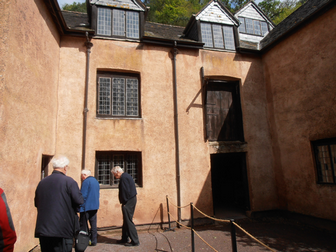
Dunster Mill entrance
|
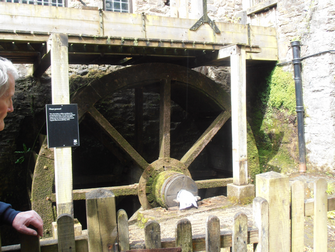
Dunster Mill wheel |
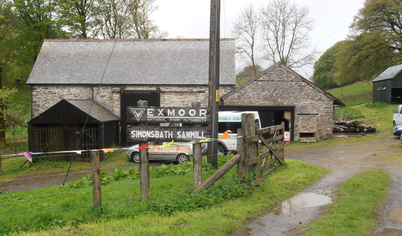
Simonsbath Saw Mill
entrance
|
On
next, to the Simonsbath Sawmill, part of a large
former estate, now in the hands of the Exmore Park
Authority since 1991.
This
water powered mill was restored to working condition
between 2002-03 with funding from the Heritage
Lottery Fund. Unfortunately sawing production
ceased in 2010 and it is now operated and maintained
by a volunteer group.
Formerly powered by one or more waterwheels, it was
adapted when a powerful Garnish and Lemon turbine
was installed in 1899. It has today two large
sawing racks and ancillary machinery plus a back-up
oil engine for driving power. We saw one saw bench
in operation which was quite impressive.
Refreshments out of the rain were welcome less than
100 yards up the hill from the sawmill.
So to the west, near
Watermouth and Hele Corn Mill, almost hidden in a
little valley behind domestic housing.
|
|
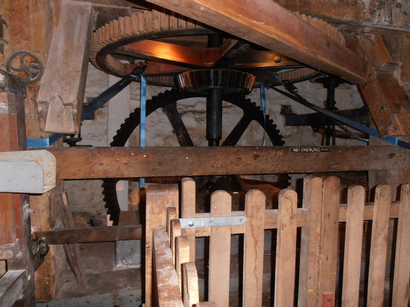
Hele
Mill main gearing |
This old watermill
dates back to the 16th century and incorporates
later millers house and stores. It underwent major
restoration in 1973 and was producing flour for
twenty years by water power, before deteriorating.
The Jones family
took over the premises in 2011 and have quickly
built up a business incorporating milling, bakery
and tea shop. Water power is aided by a 1920’s
National oil engine and flour with a Blackstone
Dreadnought Mill
This mill had a
piece of old Hampshire in the form of a ‘Horizontal
Grain Scourer with Separator and double Aspirator’
by Armfields of Ringwood. A rather rare survivor.
For some, the
highlight of the day was the cream teas. Delicious
fresh warm scones or cake with choice of cream and
jam. Before we had left, they had sold out.
Our minibus pointed
back over Exmore to Tiverton and our hotel once
more. Our evening dinner at the same eatery as
before – such good service.
|
|
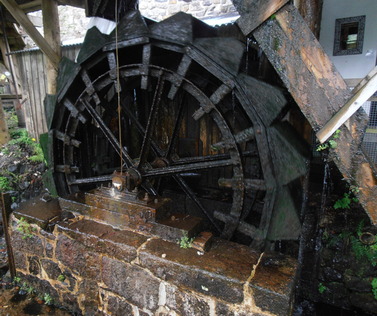
Finch Foundry water wheel
|
Sunday morning
dawned which saw us driven to our special breakfast
stop to charge up for the day ahead. After loading
our baggage back on the bus we were off to the
village of Sticklepath, on the edge of Dartmoor.
The Finch Foundry
has a long mixed history, from woollen mill to grist
mill, tool factory, sawmill, carpenters and
wheelwrights shop.
It is best known as
a forge for the making of agricultural edge tool
implements. At the rear of the building range are
three overshot waterwheels fed by timber launders.
Surviving machinery
includes tilt hammers, shear and drop hammers. Five
hearth forges, polishing wheel, band saw and
grinding house, all in working order.
Under
National Trust management, there is at the rear a
small tea shop (used for lunch snacks) and gardens
leading to Quaker Cemetery.
|
|
The
last Devon visit was to the disused metaliferous,
Kelly Mine, near Lustleigh. It worked rather
intermittently from the late 18th
century until1951. It produced micaceous iron oxide
(shiny ore) or haematite, used largely in the
production of anti-corrosion paint.
It is
sited within a steeply sloping hillside with rather
dense tree growth. The site is leased from a local
farmer by the volunteer led, Kelly Mine Preservation
Society. The site is virtually as it was left in
1951 with various leats, waterwheels, tramways,
dressing shed, stamps, washery and drying shed. Pit
shaft and underground access is not open to
visitors.
It has
a fine Blackstone oil engine, Turgo water turbine,
compressor and winch for tramway incline. Very much
an IA site with many aspects of water power use and
broad interest to many of us. This was surprisingly
my favourite site of the three days.
It was
now time to head for home via the outskirts of
Exeter and A30 to Dorset. We made a detour to view
the old mass concrete viaduct that took the old
branch rail line to Lyme Regis, otherwise we made
for West Bay for a meal stop and stretch our legs.
So on eastwards back to Hampshire in the fading
light to our respective abodes. I must express, on
behalf of my fellow travellers, the great thanks to
Andy for organising and all the driving necessary to
make this trip such a success and my fellow members
for such good company. Looking forward to 2015 and
another HMG trip.
|
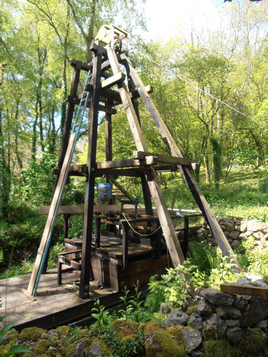
Kelly Mine Pit Head
|
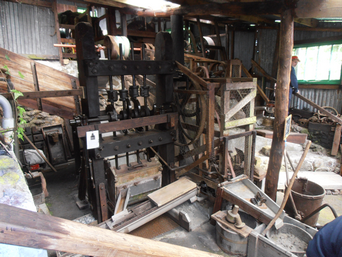
Kelly Mine Stamps |
|
|
